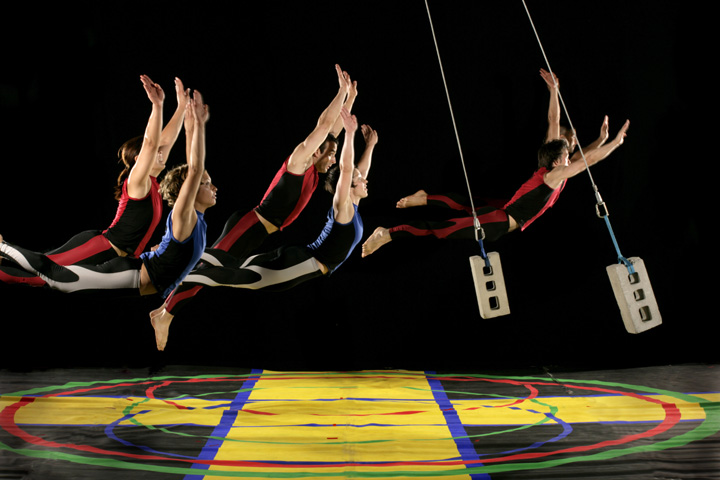
STREB performing Gauntlet. Photo by Tom Caravaglia. Courtesy Tom Caravaglia estate.
In my role at the ICA I am responsible for the success of each performance from a technical and logistical standpoint. My colleagues and I work with each incoming performance, artist, and group to establish how to fit their show into our space (which includes looking at lighting, audio, special effects, and personnel) and how to do it on time, on budget, and in a safe way.
Elizabeth Streb, a self-described “action architect,” designs shows that are made to test the limits of safety, comfort, and physicality; through her decades as a choreographer, she has honed a technique that expands the athletic boundaries of dance and has trained her dancers to protect their bodies while executing what appear, at least, to be impossible feats. Still, a show like this makes someone like me lose sleep. How do you present something that looks incredibly dangerous without actually imperiling anyone?
I remember getting the plans for the Streb show in 2009. It’s a show that’s filled with large, potentially dangerous components: an enormous hamster wheel that people climb in, around, and on top of; swinging cinderblocks that dancers dive through; and a thick plexiglass wall that dancers literally splat into. How to fit these into our very new, very delicate, glass-walled space where you can’t attach to any surface was, to say the least, a challenge. It was a million questions for Elizabeth Streb, her design team, our facilities team, our engineers, and our lawyers. It was asking the silliest-sounding questions and then trying to explain the reasoning behind the question. It was pictures and diagrams and video links sent back and forth, and it was, at each junction, saying “….hmmm, ok, but what if we…”
In the end, we found ways to make all of the elements fit. We had to place the giant hamster wheel ever so carefully so that the dancers’ heads, when they stood on top of it, were up between the lighting pipes, and there was a height limit for dancers allowed on top. We had hundreds, if not a thousand, pounds of steel blocks weighting down the plexiglass wall, but we had to spread out the point load so as not to break the floor. We had ground-supported truss holding up the cinder blocks at just the right height so that the arc of the swinging cinderblocks was at the right pace, so that the dancers could execute their (very scary looking!) movement safely, as trained.
At the culmination of months of prep work and a week of installation, I sat watching the show, perched on the edge of my seat, white-knuckled, holding my breath, witnessing incredible athletes do impossible, and crazy, things. It was an amazing show that I was proud to be involved with, and happy to see go.
See Elizabeth Streb and her dancers at work in Born to Fly: Elizabeth Streb vs. Gravity, streaming through Feb 25.